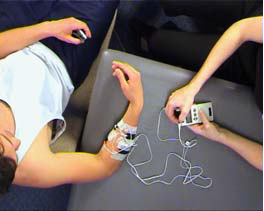AIM:
To prevent hand swelling using electrical stimulation.
Rationale:
Transcutaneous electrical stimulation (an electrical current applied across the skin
to stimulate nerve and muscle) is used to activate the forearm flexors and extensors to reduce the swelling in the hand.
Equipment:
- Table/adjustable height plinth
- Chair
- Electrical stimulation machine and electrodes
- Conducting gel, tape, alcohol wipes (not shown in video)
Key Points:
- Patient in sitting, forearm and wrist supported on plinth, forearm neutral
- Therapist applies electrodes (not shown in video):
- uses alcohol wipes to clean the skin for electrode placement
- evenly applies gel to electrodes
- securely tapes 2 electrodes onto each muscle group – for each muscle group, one is placed approximately 1/3 from the proximal end of the muscles and the second one is placed at the other end of the muscle belly (electrodes should be as far apart as is feasible))
- Ensure electrodes are not placed transthoracically or on the head/neck
- Ensure electrodes are close but not touching each other
- Therapist sets machine parameters to: mode= ALT (alternate) or SEQ (sequential)- depending on machine, current type= AC, frequency= 35 Hz, pulse duration= 100–1000 us, duty cycle (flex: ext: off time)= 10 s:10 s: 10 s, ramp= 2 s on and off, treatment time= 30 min
- Ensure therapist provides information and warning appropriate for electrical stimulation treatment
- Ensure intensity is increased while ES is in the “on cycle”
Common Errors:
- Therapist does not increase intensity during the “on cycle”
- Therapist uses too much or too little conducting gel
- Therapist does not tape electrodes securely
Progression and Variety:
- Not applicable
